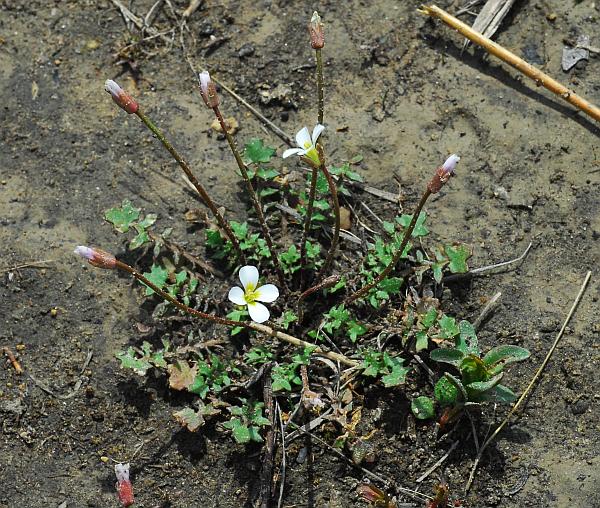Leavenworthia uniflora (Michx.) Britton
Michaux's Gladecress

Native
CC = 7
CW = 3
MOC = 32
© SRTurner
Leavenworthia uniflora (Michx.) BrittonMichaux's Gladecress | |
 |
Native CC = 7 CW = 3 MOC = 32 |
© SRTurner |
|
Family - Brassicaceae Habit - Annual forb. Stems - Absent. Leaves - Basal only, forming rosettes, petiolate, 2-10 cm long, oblanceolate in outline, pinnately lobed or divided, with 4-18 lateral lobes and 1 larger terminal lobe, these toothed or lobed, glabrous.
Inflorescences - Flowers borne singly on long leafless scapes. Flowers - Sepals 3.5-5.0 mm long, ascending, oblong, often turning purple with age. Petals 4, 5-7 mm long, 2.5-3.5 mm wide, obovate, rounded at the tip, white. Styles 1.5-3.0 mm long.
Fruit - Siliques, flattened, somewhat fleshy, erect, 1.5-3.0 cm long, not constricted between the seeds, longitudinally dehiscent. Seeds in 1 row per locule, 3-4 mm in diameter, circular, flattened, winged, the surface with a netlike or honeycomblike pattern of ridges and pits, dark brown.
Flowering - March - April. Habitat - Limestone and dolomite glades. Origin - Native to the U.S. Lookalikes - Leavenworthia torulosa, which is very rare. Other info. - This little plant is one of Missouri's smallest mustards, typically standing only a few inches high. It occurs mostly in the southern half of the state, always on calcareous glades where the soil is thin and rocky. Its entire global range is limited to a few states in the east-central portion of the U.S. Missouri probably has the largest population of any state. Photographs taken at Washington State Park, Washington County, MO, 4-14-2011 and 4-21-2014, Valley View Glade Natural Area, Jefferson County, MO, 4-11-2014, St. Joe State Park, St. Francois County, MO, 4-26-2014, 3-31-2015, 4-11-2018, 3-26-2020, and 5-5-2025, and Shaw Nature Reserve, Franklin County, MO, 3-29-2023 (SRTurner). |